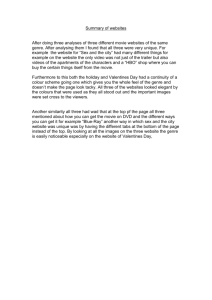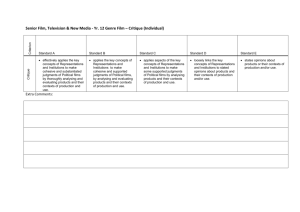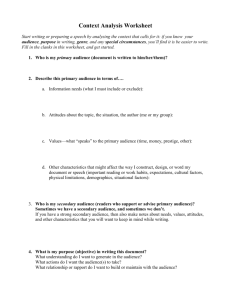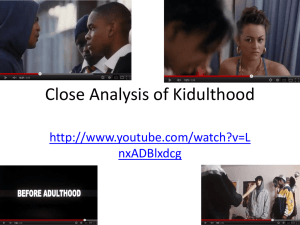OCR G325 A2 Media Studies Time allowed – 2 hrs. Answer Section
advertisement
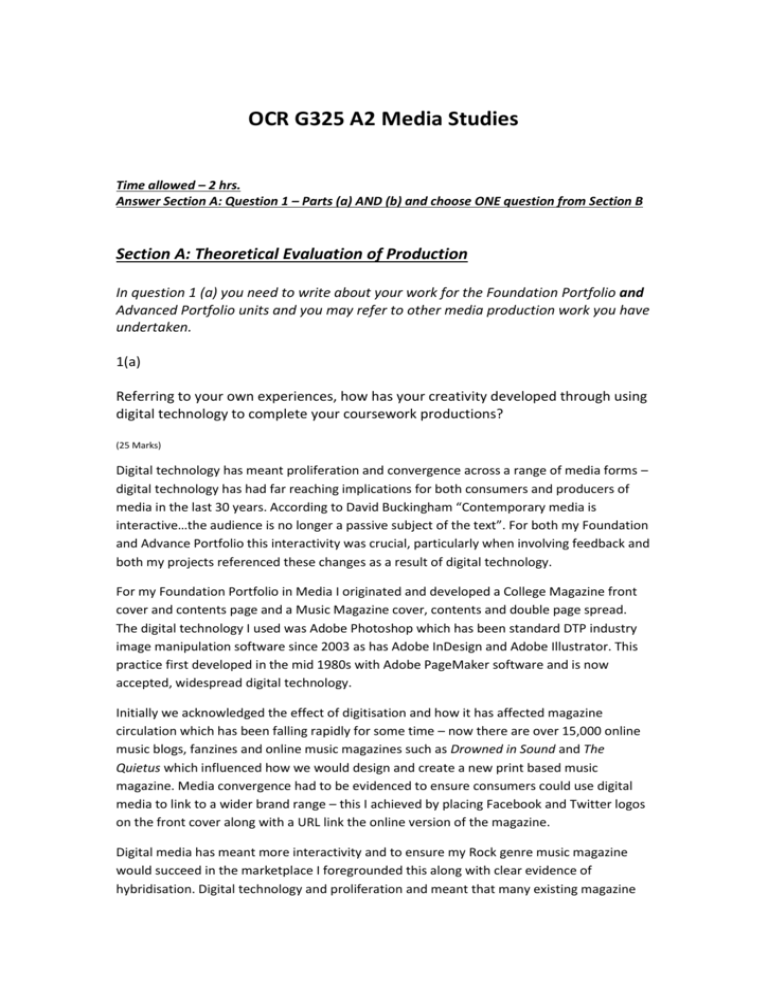
OCR G325 A2 Media Studies Time allowed – 2 hrs. Answer Section A: Question 1 – Parts (a) AND (b) and choose ONE question from Section B Section A: Theoretical Evaluation of Production In question 1 (a) you need to write about your work for the Foundation Portfolio and Advanced Portfolio units and you may refer to other media production work you have undertaken. 1(a) Referring to your own experiences, how has your creativity developed through using digital technology to complete your coursework productions? (25 Marks) Digital technology has meant proliferation and convergence across a range of media forms – digital technology has had far reaching implications for both consumers and producers of media in the last 30 years. According to David Buckingham “Contemporary media is interactive…the audience is no longer a passive subject of the text”. For both my Foundation and Advance Portfolio this interactivity was crucial, particularly when involving feedback and both my projects referenced these changes as a result of digital technology. For my Foundation Portfolio in Media I originated and developed a College Magazine front cover and contents page and a Music Magazine cover, contents and double page spread. The digital technology I used was Adobe Photoshop which has been standard DTP industry image manipulation software since 2003 as has Adobe InDesign and Adobe Illustrator. This practice first developed in the mid 1980s with Adobe PageMaker software and is now accepted, widespread digital technology. Initially we acknowledged the effect of digitisation and how it has affected magazine circulation which has been falling rapidly for some time – now there are over 15,000 online music blogs, fanzines and online music magazines such as Drowned in Sound and The Quietus which influenced how we would design and create a new print based music magazine. Media convergence had to be evidenced to ensure consumers could use digital media to link to a wider brand range – this I achieved by placing Facebook and Twitter logos on the front cover along with a URL link the online version of the magazine. Digital media has meant more interactivity and to ensure my Rock genre music magazine would succeed in the marketplace I foregrounded this along with clear evidence of hybridisation. Digital technology and proliferation and meant that many existing magazine like Kerrang and Q had had to creatively interpret the needs of their readers by catering to a range of genres – I hybridised my Rock magazine with Indie music reflected by the cover lines and features on my contents page. My magazine would also be published by Bauer because despite the rise of independent publications as a result of digital media I knew that to have a chance of commercial success it would need to be funded by a major oligopoly publishing house. Once we had chosen a genre I used a digital stills camera and organised a photo shoot to ensure that my images could easily be uploaded into Photoshop for selection, editing and manipulation. Experimenting with the tools and options in Photoshop designing my College Magazine allowed me to make the creative decision to use Adobe Photoshop alone to design my Music Magazine cover, contents and double page spread – this is because I believe that Adobe Photoshop CS6 allows the user to manipulate text and image to a high level of sophistication although reflecting on the production I would probably use Photoshop in conjunction with InDesign as I was new to both the software and the Apple MAC OS X hardware that I used. This probably affected my ability to fully utilise my creative potential although I did find the software allowed me to manipulate text and image to a near sophisticated level including use of the Clone Stamp Tool, the Lasso and Crop tool, applying filters to my images and also selecting brushes to blur and sharpen. I found the range of fonts of Photoshop extensive but not suitable for the creative impact I was hoping to achieve, particularly in my masthead. As a result I downloaded fonts from www.dafont.com to achieve my desired finish. My creativity had also developed from using the Internet as a secondary research tool looking at OCR blogs (Weebly) to study existing coursework productions to enable me to understand the levels of assessment and how they compared to my designs. In my Advanced Portfolio for Media we also used Photoshop to develop and design two ancillary tasks, a film poster an independent film magazine cover as part of a promotional campaign to launch a social realist production which I had filmed and edited a teaser trailer for. I found my ancillary tasks evidenced a higher level of design sophistication as a result of my increasing familiarity with Adobe Photoshop from my Foundation Portfolio tasks – my poster and magazine front cover revealed not just my technological competence but also my increasing awareness of the conventions of layout, use of space (my productions were more minimalist that my Music Magazine work) and also my artistic interpretation of design in relation to genre conventions. I am looking forward to using YouTube as an example of Web 2.0 to obtain interactive feedback on my Advanced Portfolio in Media main task, filming and editing a short social realist teaser trailer – digital technology has meant that producers can easily upload short films onto file sharing sites, social networking sites or blogs for audience feedback and for marketing purposes. YouTube is significantly important in the history of consumers of media who now more easily have become producers according to David Gauntlett and also allows for faster, more collaborative creativity from subsequent feedback. YouTube also allowed me to study existing social realist film trailers to ensure I was familiar with both the conventions of a teaser trailer but also the genre. In using digital film technology to develop my main task (DV cameras and non linear editing) I linked with the conventions of independent media with many new and existing Directors choosing to shoot in this format. Lightweight, portable hand held digital cameras with built in mics for sound pick up allowed me to complete complex filming (particularly in regards to shot selection) which with film stock would have been expensive and time consuming in terms of set up. This in turn enhanced my creativity by the ability to innovate and film quickly, capturing the immediacy of a scene. My social realist film borrows from the conventions of the documentary genre in this regard. I then captured the footage onto the hard drive and uploaded it into Final Cut Pro – industry standard editing software. Although I had not used Final Cut Pro before I was able to utilise my transferable IT skills from editing a external project using Adobe Premiere. Although the two software packages are very different I quickly learnt how to use Final Cut Pro from both teacher led and online tutorials in areas that I was not particularly confident with. I also benefitted from tutorials from our Media Technician who is also a film maker using a wide range of transitions I was able to conform to the conventions of a teaser trailer which include fast paced editing to engage target audience via narrative enigma. I also edited in non-diegetic sound (a music soundtrack) and titles to enhance and anchor my narrative and combined these with a range of different special effects including turning footage to black and white but always recognising that I was editing a genre with realist, urban representations. I feel that I am now multi skilled in relation to my understanding of print based and audio-visual digital technology and that my creativity has developed from my Foundation to Advanced Portfolio to the point that I am now prepared to innovate more and take risks. I experienced technical problems and difficulties throughout both projects but importantly designed solutions to overcome them. 1(b) Analyse one of your coursework productions in relation to genre. (25 Marks) Analyse one of your Coursework Productions in terms of Genre I will be analysing my teaser trailer that I filmed and edited as my main task forming part of my Advanced Portfolio in Media. In class, we studied genre in existing social realist films such as Shifty, This is England, Fish Tank and Kidulthood. This enabled me to fully understand how genre conventions can be applied to our own productions. In my social realist teaser trailer urban representations have clear connotations of social class that commonly are the encoded narrative themes of existing social realist texts like Bullet Boy (2004) and Shank (2010) that target a younger demographic. According to Steve Neale “Genre are instances of repetition and difference” – this relates directly to how social realism has changed to appeal to a broader demographic. Like contemporary social realism my trailer appeals to a C1, C2, D, 1625, male/female, aspirer/mainstreamer, urban/city living demographic. I remained faithful to the core conventions of the genre but I encode narrative themes that would appeal to a younger, more regionally specific (East London) target audience. However, stereotypically I cast a male central protagonist which references these historical and traditional conventions in 1950s films like Saturday Night, Sunday Morning right through to contemporary social realism in Shifty (2008). This suggests that as a genre piece my film trailer was ‘safe’ and did not offer the more pluralistic representations of character found in films like Fish Tank (2009) and Happy go Lucky (2008) with their strong, feminised narratives. My central character conformed to the genre template as a typically aspirational, frustrated young man who is aspiring for a better life. He is working class, male and looking for something different, looking to break out of a negative spiral and ‘be something’. Filmed and set in around East London council estates the trailer depicts a stereotypical social realism urban environment. The mise-en-scene evidences this gritty urban realism by use of dress code, objects and props such as graffiti - alleyway shots reveal urban decay and use of natural lighting gives the trailer a documentary feel. The body language and attitude of the characters makes intertextual references to specifically regional social realist films such as Adulthood (2008) and Ill Manors (2012) and uses similar visual iconography. Some locations are domestic environments again ensuring notions of ‘kitchen sink dramas’ apply but ensuring a contemporary feel. This is reflected by David Buckingham’s analysis of genre where he states “Genre is not simply given by the culture; rather it is in a constant process of negotiation and change” – my attempts have been exactly that, to reference how social realism has evolved but by ensuring core genre conventions apply/ The technical composition of my trailer included wide, establishing shots of stereotypical social realist locations (a council estate), use of hand held camera anchoring realism and non-diegetic sound with problematical urban connotations. This was an artistic choice but also recognition of genre conventions – it would be highly likely that the film itself would have no non-diegetic sound to further encode realism. This realism would allow audiences to develop an understanding of the narrative themes evident in the trailer, again typical to social realism. My themes include mental health and xenophobia and through narrative enigma in the trailer this is suggested to audiences. Other narrative themes common to social realism evident in my trailer includes exploration of social class and urban gang culture although I have made significant efforts to not hybridise the genre into gangster codes and conventions which is a criticism made of some contemporary social realist films like Kidulthood (2006). However, as Henry Jenkins argues genre has commonly been subject to hybridisation and change to broaden target audiences in terms of audience appeal. John Fiske argues that the whole concept of genre is deliberate and potentially commercial by stating “Attempts to structure some order into the wide range of texts and meanings that circulate in our culture are for the convenience of both producers and audiences”. Like many social realist films by production is independent with low budget production values reflecting the fact that many films of this genre are more likely to achieve critical and not commercial success unless, like The Full Monty (1996) they are distributed by a major studio. This makes my trailer, as part of a promotional campaign to primarily market to niche audiences with significant cultural capital in terms of narrative content. In this regard John Hartley’s comments on genre that “The same text can belong to different genre in different countries or times” applies. As a result of its regional skew my trailer is unlikely to have broad, international appeal and is more likely to be distributed online e.g. via YouTube with a limited theatrical release like Fish Tank which was only distributed to 40 cinemas but has since achieved critical success. Section B: Contemporary Media Issues Media in the Online Age (MediaEdu choice from 6 topics - extended responses/articles and analysis of Postmodern Media, Collective Media Identity and Contemporary Media Regulation are also available on MediaEdu). 2. Discuss the extent to which the distribution and consumption of media has been transformed by the internet. (50 Marks) 3. Referring to at least two media in your answer, explain and illustrate the idea of convergence. (50 Marks) Media in the Online Age Discuss the extent to which the distribution and consumption of media has been transformed by the internet. The internet or world wide web is a tool of global communication – billions of pages of unregulated content (in most countries) that has transformed the way we live our lives, including revolutionising consumption of media. Sociologist and Media theorist David Gauntlett has focused his recent work on digital and social media and its relationship with self identity while he also acknowledges the blurring of the boundaries of producer and consumer as a result of ‘new media’ such as YouTube (b. 2005). David Buckingham has focused his work on the way digital technologies are used in everyday life and their consequences for individuals and social group – his key area of concern is children, use and access to technology in education. Both theorists however recognise the revolutionary impact that the internet has had on our lives. Media convergence is a key transformation with traditional media becoming available in online formats from film to music downloading and distribution to online television, online gaming, online news provision, newspapers and magazines. I intend to focus on two media, music and magazines to illustrate the changes in the distribution and consumption of media within these industries. Effectively the internet has become a single platform where access to rich media is almost limitless and can be downloaded at the click of a mouse button, often resisting traditional media regulation, promoting global culture that does not recognise national boundaries and changing the very nature of how we consume media – with convergence come interactivity and immediacy and the fragmentation of traditional audiences. The music industry naturally converges with other media, e.g. through music videos, through film soundtracks, through television and through radio but through the internet the distribution and consumption of music has dramatically and permanently changed – sales of CDs have fallen to the point that the format is now almost obsolete with the majority of purchases made through online sites like iTunes. This has in turn been reflected by the site of distribution with historical distributors like HMV going into administration in January 2013, unable to compete with online formats. Distribution literally defines the way music is delivered and now online stores and downloading monopolises music consumption. Debates about illegal downloading rage with argument and counter argument suggesting that illegal downloading is the primary reason why record and CD sales have fallen. The oppositional view suggests that illegal downloading actually make consumers more aware of the marketplace and what is out there. Online distributors often have key arrangements with the ‘Big Three’ music publishers, Sony, Warners and Universal with the online distributor taking a cut and paying the balance to the record label. Universal Music claim there has been a 20% fall in CD sales since 2006 and are involved in frequent lawsuits to prevent digital piracy. Universal, and many of their artists still remain commercially successful however via take-overs and monopolizing and controlling online distribution as in Vevo, their recent coloration with Sony and Abu Dhabi Entertainment. Started in 2009 (April 2011 in the UK) Vevo are a mainstream video hosting website that has meant it is now harder to search for a well-known artist’s video via a generic YouTube search. Approximately 50,000 videos are available with the ability to control and benefit in a more structured way from advertising revenue – the videos are syndicates across the web with Google and Vevo sharing the advertising revenue. Most videos available are licensed to the Big Three (until 2011 with the break up of EMI this was known as the Big Four). One of the key impacts in terms of consumption, to ensure attracting high-end advertisers is the censoring of content, particularly in terms of language. Further revenue is generated from a merchandise store and links to purchase viewed songs on Amazon MP3 and iTunes – iTunes itself remains a dominant application developed by Apple in 2001 that allows users the opportunity to play, download and organize music (and music videos, television and some film content) on all computer platforms. Simple accessibility has allowed for this wide distribution of music through an iTunes store although criticisms have been leveled against Apple for developing what has become regarded as a monopoly. Music industry websites have become crucial to the industry as a marketing tool - typically star sites are managed and run by the record company and use marketing, synergy and convergence to link to Photo Galleries, links and downloads, lyrics, bibliographies and news, gigs and merchandising which is all part of promoting the artist. Official Product Sites also allow consumers to develop their interest in an artist or a brand – an example would be www.glastonburyfestivals.co.uk which is the website of the Glastonbury Music Festival organised and is run by Festival Republic who used to be part of the Mean Fiddler (Vince Power) music group. Fan Sites like www.katyfan.com are often created to distribute specialist information and encode notions of exclusivity to the more dedicated fan. This fits with Blumler and Katz’s 1975 Uses and Gratifications theory suggesting audiences are active in developing personal relationships with other fans of the artist, which is evidenced by the use of Katy Perry’s first name only. Social Networking Sites like Facebook and Twitter are also important to music artists and contain alleged personal information and are used in marketing to maintain a mythical close relationship with the fans. Importantly they are often run by the record company, and not the artist. On Lady Gaga’s own website she is pictured in a standard hero shot within the leaderboard in stereotypical pose. Like all the photographs that the website will link to, all will have been authorised by the record company in terms of publicity. The colour palette is not too feminine and conventions of graphic design and layout are nearly sophisticated. Standard conventions are used as a marketing tool including merchandising links to an online shop, events and a chat page which also advertises Lady Gaga’s Facebook and Twitter page (again all paid for and authorised by the record company). It is only Music Industry Fan Sites that contain material that is not always acknowledged and authorised by the likes of Sony and Universal. A button will allow easy navigation to the music video of Lady Gaga’s latest single, her biography, ticket sales and downloads through iTunes. In again an intelligent marketing ploy, foregrounded on the home page are messages from fans to Gaga creating the myth of personal communication which is anchored by her social networking sites. Synergy and convergent links are crucial to Music Industry Star Sites in how they have transformed the distribution and consumption of music. Online distribution has also benefitted the independent sector with lower production costs and the ability to reach a broader audience than before – as identified earlier, Gauntlett would argue more and more consumers are now producers with a new range of ‘internet stars’ breaking into the industry like Justin Beiber. Key advantages of independent online music publishing include no studio costs, more immediate profit (although this is often negligible) and the ability to develop a viral marketing campaign via interactive social networking media. YouTube has allowed for user generated content but regularly the top ten viewed YouTube videos are often corporate music videos by well-known artists like Lady Gaga, Kanye West, Lil Wayne, Eminem (who has retained popularity online) and the aforementioned Bieber. Online music distribution and publishing is still fundamentally dominated by the Big Three who comprise the oligopoly ownership. The Magazine industry provides and interesting comparison – like the music industry, before widespread online publishing and consumption an oligopoly dominated and arguably still does in the guise of companies like Bauer, IPC and Hearst Publishing (previously NMC). However, the widespread proliferation of online magazines and the internet providing such a broad range of immediate entertainment print magazine circulation has dramatically fallen. ABC figures indicate year on year circulation has fallen but also acknowledging that figures can be blurred by ‘digital copies’ on the print publication. Many printed version of magazines, despite hanging on to the iconic product are now actively diverting consumers to websites maintain and develop interest in the brand – URL and Twitter and Facebook logos are now common on the front page of printed magazines to ensure convergence. Linking with the above analysis of how the internet has affected the distribution and consumption of the music industry it is now widely recognised that there are over 15,000 music industry online magazines, blogs, fanzines and online versions of existing magazines. Stand alone music magazines like www.drownedinsound.com and www.thequietus.com are example of music magazines that only (successfully) publish online. Key advantages of online magazines focus on interactivity and as such, focus on interactive content such as forums, blogs, social networking and convergent links to rich media – all unavailable in print format. Advertising is more evident on the home page of an online magazine with banners, skyscrapers, buttons and flash animations common. The proliferation of advertising online reflects essential funding as per ad impressions of hits on that particular magazine’s website. Genre has arguably also been subject to proliferation as magazines offer more obvious genre conventions in their printed format. This is supported by Daniel Chandler who suggests “Conventional theories of genre tend to be based on the notion that they constitute particular conventions of content”. In online format the obvious conventions of Men’s Lifestyle Magazines like Shortlist, Music Magazines like Kerrang and style magazines like 1-D. www.i-donline.com in their leaderboard advertises fashion, music, culture and film, printed magazine genres in their own right but also has links to their iconic magazine front pages. This hybridisation has been facilitated by the range of entertainment the internet can offer and the way the medium has dramatically changed the way we think about media, and what media is. It is often cheaper and easier to view magazines online and there is a wide diversification. Convergent links stereotypically appeal to a broader range of youth audiences although the myth of youth and online technology is slowly being eroded with all bar the older generation now recognised as competent online consumer of media – indeed a significant group of online gamers are 35-55, ABC1 males. The magazine industry continues however, albeit with reduced circulation figures but common to all recognising the importance of the print version as a product that may be publishing at a loss but that provides vital links to online versions. On occasion, a printed magazine’s circulation can level out; the Radio Times is a magazine that is read traditionally by an older demographic but recently their website, www.radiotimes.com has been re-launched describing itself as a ‘one stop shop’ for what is on television, radio, on demand and at the cinema with additional information on entertainment news, views and guides. The printed version cannot compete with this vast content but also convergent links to videos, cinema trailers and an archive of 30,000 film reviews. Notions of the ‘archive’ ensure the superiority of magazines in online format compared the to singularity of a printed product (the magazine). Even Gossip magazines, commonly read and commonly seen all have a significant online presence that provides additional and broader ranging content – www.heatworld.com provides synergy with the ever-expanding Reality TV genre in the same way that www.kerrangcom links to Kerrang TV and Kerrang Radio. Complete proliferation has ensured that both the distribution and consumption of media via the internet has changed. Henry Jenkins suggested “Everyone is a producer of media, the desire to create and share is great and we can now communicate across geographical barriers”. The internet does not recognise global boundaries, the whole concept of media is shared. Commercially the internet has facilitate significant change although in somd media this may be underestimated – if you add up all the revenue from niched market films the profit (ROI – return on investment) can be greater or at least equal to one blockbuster. The explosion of broadband technology has now meant that media consumption of larger forms, such as a 90 minute film has increased. The interactive, sharing, social networking and peer to peer aspects web 2.0 have further changed media consumption and distribution. However, the argument exists that much global media on the internet ‘comes from the west’ suggesting a form of cultural homogenisation whereby generic forms are established, expected and regularly consumed. Immediacy is also an issue with many consumers not prepared to wait for, or use the ‘real product’ e.g. a DVD and search instantly via YouTube suggesting changes in terms of exhibition. The whole idea of targeted marketing again is facilitated by online formats with cookies tracing for examples, films that you have looked at with ensuing advertising pop ups, prosumers like Charlie McDonnell represents a new brand of media consumer who makes a living from creating their own films or TV shows and streaming them online for free – the face of media consumption is changing with traditional formats declining with audiences ditching the traditional concept of gatekeeping and going straight to the web.



